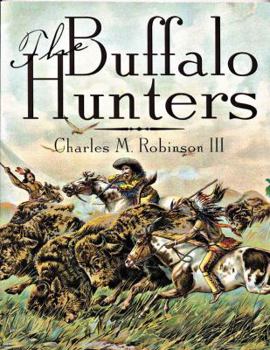The Buffalo Hunters
Select Format
Select Condition 
Book Overview
The near extinction of the North American buffalo, which in 1850 covered the mid-western plains by countless millions but which had been hunted to near-oblivion within thirty-five years, is one of the... This description may be from another edition of this product.
Format:Paperback
Language:English
ISBN:1880510197
ISBN13:9781880510193
Release Date:January 1995
Publisher:TX A&m-McWhiney Foundation
Length:176 Pages
Weight:1.10 lbs.
Dimensions:0.6" x 8.5" x 11.0"
Age Range:10 to 22 years
Grade Range:Grade 5 to Postsecondary
Customer Reviews
1 rating
The only good buffalo is a dead buffalo...
Published by Thriftbooks.com User , 17 years ago
Robinson's book is a wonderful introduction to the sorry nineteenth-century tale of the near extinction of buffalo in the Great Plains and Texas Panhandle. The bulk of the destruction occurred in the 1870s and 1880s. Most of the buffalo were killed either for their pelts--this was especially the case with the northern herds--or, in the case of the southern herds, for their hides, which were made into tough industrial leather for New England factory conveyer belts. One estimate calculates that during these two decades, only one-thousandth of the slain buffaloes' meat was actually eaten, and that the wasted meat could've fed one million people. Everyone knows that the buffalo were wantonly killed. But what may not be equally well-known is that the extermination of the buffalo was apparently a deliberate tactic on the part of the U.S. military, then headed by Phil Sheridan of Civil War fame, to exterminate the Indians. The thinking was that since the Plains Indians' economy was almost totally centered on the buffalo, the destruction of the buffalo would starve Indians, thereby either killing them or forcing them onto reservations. In fact, starting in the early 1870s, the Army supplied free powder and shot to civilian hunters. According to Phil Sheridan (who, it might be recalled, first made a name for himself by waging Civil War destruction in the Shenandoah Valley), buffalo hunters "have done in the last two years and will do more in the next year [Sheridan wrote this in 1875], to settle the vexed Indian question, than the entire regular Army has done in the last thirty years. They are destroying the Indians' commissary; and it is a well-known fact that an army losing its base of supplies is placed at a great disadvantage...[F]or the sake of a lasting peace, let [the hunters] kill, skin and sell until the buffaloes are exterminated" (pp. 102-103). In short, the destruction of the buffalo was, at least according to the military, a strategy of the same total war, this time waged against the Indians, that Sheridan, Sherman and Grant honed in the Civil War. Robinson's book is a fascinating, although sober, read. Some of the photographs in the photo-essays interspersed between chapters didn't reproduce well, and the book could've profited from a map or two. But all in all, an admirable job.






